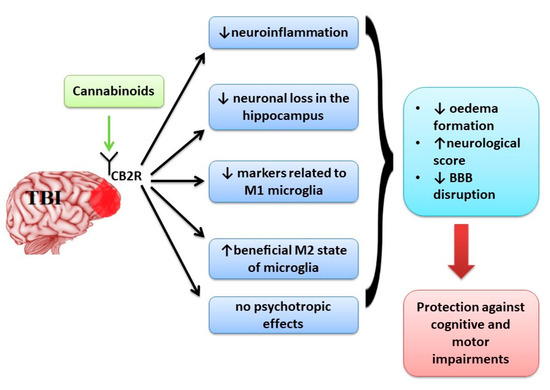 “Despite the high incidence of traumatic brain injury (TBI), there is no universal treatment to safely treat patients. Blunt brain injuries destroy primary neural tissue that results in impaired perfusion, excessive release of glutamate, inflammation, excitotoxicity, and progressive secondary neuronal cell death.
“Despite the high incidence of traumatic brain injury (TBI), there is no universal treatment to safely treat patients. Blunt brain injuries destroy primary neural tissue that results in impaired perfusion, excessive release of glutamate, inflammation, excitotoxicity, and progressive secondary neuronal cell death.
We hypothesized that administration of cannabidiol (CBD) directly to a brain contusion site, will optimize delivery to the injured tissue which will reduce local neural excitation and inflammation to spare neural tissue and improve neurological outcome following TBI.
CBD was infused into a gelfoam matrix forming an implant (CBDi), then applied over the dura at the contusion site as well as delivered systemically by injection (CBD.IP). Post-injury administration of CBDi+IP greatly reduced defecation scores, lesion volume, the loss of neurons in the ipsilateral hippocampus, the number of injured neurons of the contralateral hippocampus, and reversed TBI-induced glial fibrillary acidic protein (GFAP) upregulation which was superior to either CBD.IP or CBDi treatment alone.
Vestibulomotor performance on the beam-balance test was restored by 12 days post-TBI and sustained through 28 days. CBDi+IP treated rats exhibited preinjury levels of spontaneous alternation on the spontaneous alternation T-maze. In the object recognition test, they had greater mobility and exploration of novel objects compared to contusion or implant alone consistent with reduced anxiety and restored cognitive function.
These results suggest that dual therapy by targeting the site of injury internally with a CBD-infused medical carrier followed by systemic supplementation may offer a more effective countermeasure than systemic or implant treatment alone for the deleterious effects of penetrating head wounds.”
“CBD improved vestibulomotor function and learning and memory cognitive performance post-TBI. Local delivery at the contusion site and systemic injection of CBD reduced TBI-induced lesion volume. Dual treatment, direct and systemic CBD, is superior to single treatment.”
https://www.sciencedirect.com/science/article/abs/pii/S0014488621002521?via%3Dihub

 “The hematopoietic cytokine granulocyte-colony stimulating factor (G-CSF) is well known to stimulate proliferation of blood stem/progenitor cells of the leukocyte lineage, but is also recognized as a neurotrophic factor involved in brain self-repair processes. G-CSF administration has been shown to promote recovery from experimental models of traumatic brain injury (TBI) and to modulate components of the endocannabinoid system (eCS). Conversely, Δ9-tetrahydrocannabinol (
“The hematopoietic cytokine granulocyte-colony stimulating factor (G-CSF) is well known to stimulate proliferation of blood stem/progenitor cells of the leukocyte lineage, but is also recognized as a neurotrophic factor involved in brain self-repair processes. G-CSF administration has been shown to promote recovery from experimental models of traumatic brain injury (TBI) and to modulate components of the endocannabinoid system (eCS). Conversely, Δ9-tetrahydrocannabinol ( “There is not a single pharmacological agent with demonstrated therapeutic efficacy for traumatic brain injury (TBI). With recent legalization efforts and the growing popularity of medical cannabis, patients with TBI will inevitably consider medical cannabis as a treatment option.
“There is not a single pharmacological agent with demonstrated therapeutic efficacy for traumatic brain injury (TBI). With recent legalization efforts and the growing popularity of medical cannabis, patients with TBI will inevitably consider medical cannabis as a treatment option. “The prevalence of mild traumatic brain injury is highest amongst the adolescent population and can lead to complications including neuroinflammation and excitotoxicity.
“The prevalence of mild traumatic brain injury is highest amongst the adolescent population and can lead to complications including neuroinflammation and excitotoxicity. “Neurological disorders such as neurodegenerative diseases or traumatic brain injury are associated with cognitive, motor and behavioural changes that influence the quality of life of the patients. Although different therapeutic strategies have been developed and tried until now to decrease the neurological decline, no treatment has been found to cure these pathologies.
“Neurological disorders such as neurodegenerative diseases or traumatic brain injury are associated with cognitive, motor and behavioural changes that influence the quality of life of the patients. Although different therapeutic strategies have been developed and tried until now to decrease the neurological decline, no treatment has been found to cure these pathologies.
 “Recently, several studies have reported that the pharmacological effects exerted by
“Recently, several studies have reported that the pharmacological effects exerted by  “In the sports domain, cannabis is prohibited by the World Anti-Doping Agency (WADA) across all sports in competition since 2004. The few studies on physical exercise and cannabis focused on the main compound i.e. Δ9-tetrahydrocannabinol.
“In the sports domain, cannabis is prohibited by the World Anti-Doping Agency (WADA) across all sports in competition since 2004. The few studies on physical exercise and cannabis focused on the main compound i.e. Δ9-tetrahydrocannabinol.  “To determine whether adjunctive dronabinol, a licensed form of delta-9-tetrahydrocannabinol, reduces opioid consumption when used off-label for managing acute pain following traumatic injury.
“To determine whether adjunctive dronabinol, a licensed form of delta-9-tetrahydrocannabinol, reduces opioid consumption when used off-label for managing acute pain following traumatic injury. “Brain trauma was clinically associated with increased osteogenesis in the appendicular skeleton. We showed previously in C57BL/6J mice that mild traumatic brain injury (mTBI) transiently induced bone formation in the femur via the
“Brain trauma was clinically associated with increased osteogenesis in the appendicular skeleton. We showed previously in C57BL/6J mice that mild traumatic brain injury (mTBI) transiently induced bone formation in the femur via the